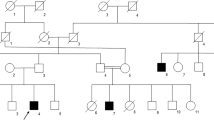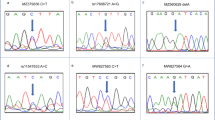Abstract
We investigated the polymorphisms/mutations in synaptonemal complex central element protein 1 (SYCE1) and CDC25A mRNA-binding protein (BOLL) to test whether they increase the risk of azoospermia among Bengali-speaking men from West Bengal, India. Sanger’s dideoxy sequencing was used to genotype 140 azoospermic individuals who tested negative for Y chromosome microdeletion and 120 healthy controls. In both cases and controls, qRT-PCR was used to determine the expression summary of SYCE1 and BOLL. The perceived harmful consequences of identified mutations were inferred using in silico analysis. Suitable statistical approaches were used to conduct the association study. We found SYCE1 177insT (ON245141), 10650T > G (ON257012), 10093insT (ON257013), 10653insG (ON292504), rs10857748A > G, rs10857749G > A, and rs10857750T > A and BOLL 7708T > A (ON245141insT), rs72918816T > C, and rs700655C > T variants with the prevalence of azoospermia. Data from qRT-PCR and in silico studies projected that the variations would either disrupt the transcript’s natural splice junctions or cause probable damage to the structure of the genes’ proteins. SYCE1 gene variants [177insT (ON245141), 10650T > G (ON257012), 10093insT (ON257013), 10653insG (ON292504), rs10857748A > G, rs10857749G > A, rs10857750T > A] and BOLL gene variants [7708T > A (ON245141insT), rs72918816T > C, rs700655C > T] reduce the expression of respective gene in testicular tissue among azoospermic male as revealed from qRT-PCR result. These genetic variations could be utilized as screening tools for male infertility to determine the best course of treatment in routine ART practise.
Graphical Abstract














Similar content being viewed by others
Data availability
The data that support the findings of this study are available on request from the corresponding author.
Code availability
Not applicable.
References
Agarwal A, Mulgund A, Hamada A, Chyatte MR. A unique view on male infertility around the globe. Reprod Biol Endocrinol. 2015;26(13):37.
Roy A, Lin Y-N, Matzuk MM. Genetics of idiopathic male infertility. In: Carrell DT, editor. The genetics of male infertility. Totowa, NJ: Humana Press; 2007. p. 99–111.
Liu S-Y, Zhang C-J, Peng H-Y, Sun H, Lin K-Q, Huang X-Q, et al. Strong association of SLC1A1 and DPF3 gene variants with idiopathic male infertility in Han Chinese. Asian J Androl. 2017;19(4):486–92.
Dong Y, Pan Y, Wang R, Zhang Z, Xi Q, Liu RZ. Copy number variations in spermatogenic failure patients with chromosomal abnormalities and unexplained azoospermia. Genet Mol Res. 2015;14(4):16041–9.
Soumillon M, Necsulea A, Weier M, Brawand D, Zhang X, Gu H, et al. Cellular source and mechanisms of high transcriptome complexity in the mammalian testis. Cell Rep. 2013;3(6):2179–90.
Dunne OM, Davies OR. Molecular structure of human synaptonemal complex protein SYCE1. Chromosoma. 2019;128(3):223–36.
Costa Y, Speed R, Ollinger R, Alsheimer M, Semple CA, Gautier P, et al. Two novel proteins recruited by synaptonemal complex protein 1 (SYCP1) are at the centre of meiosis. J Cell Sci. 2005;118(Pt 12):2755–62.
Sánchez-Sáez F, Gómez-H L, Dunne OM, Gallego-Páramo C, Felipe-Medina N, Sánchez-Martín M, et al. Meiotic chromosome synapsis depends on multivalent SYCE1-SIX6OS1 interactions that are disrupted in cases of human infertility. Sci Adv. 2020;6(36):eabb1660. https://doi.org/10.1126/sciadv.abb1660.
Maor-Sagie E, Cinnamon Y, Yaacov B, Shaag A, Goldsmidt H, Zenvirt S, et al. Deleterious mutation in SYCE1 is associated with non-obstructive azoospermia. J Assist Reprod Genet. 2015;32(6):887–91.
Huang Y, Tian R, Xu J, Ji Z, Zhang Y, Zhao L, et al. Novel copy number variations within SYCE1 caused meiotic arrest and non-obstructive azoospermia. BMC Med Genomics. 2022;15(1):137.
Feng K, Ge H, Chen H, Cui C, Zhang S, Zhang C, et al. Novel exon mutation in SYCE1 gene is associated with non-obstructive azoospermia. J Cell Mol Med. 2022;26(4):1245–52.
Luetjens CM, Xu EY, RejoPera RA, Kamischke A, Nieschlag E, Gromoll J. Association of meiotic arrest with lack of BOULE protein expression in infertile men. J Clin Endocrinol Metab. 2004;89(4):1926–33.
Lin YM, Chung CL, Cheng YS. Posttranscriptional regulation of CDC25A by BOLL is a conserved fertility mechanism essential for human spermatogenesis. J Clin Endocrinol Metab. 2009;94(7):2650–7.
Neuvians TP, Gashaw I, Sauer CG, von Ostau C, Kliesch S, Bergmann M, et al. Standardization strategy for quantitative PCR in human seminoma and normal testis. J Biotechnol. 2005;117(2):163–71.
Livak KJ, Schmittgen TD. Analysis of relative gene expression data using real-time quantitative PCR and the 2(-Delta Delta C(T)) Method. Methods. 2001;25(4):402–8.
Choi Y, Chan AP. PROVEAN web server: a tool to predict the functional effect of amino acid substitutions and indels. Bioinformatics. 2015;31(16):2745–7.
Capriotti E, Fariselli P, Casadio R. I-Mutant2.0: predicting stability changes upon mutation from the protein sequence or structure. Nucleic Acids Res. 2005;33(Suppl_2):W306-10. https://doi.org/10.1093/nar/gki375.
Rogers MF, Shihab HA, Mort M, Cooper DN, Gaunt TR, Campbell C. FATHMM-XF: accurate prediction of pathogenic point mutations via extended features. Bioinformatics. 2018;34(3):511–3.
Shihab HA, Rogers MF, Gough J, Mort M, Cooper DN, Day INM, et al. An integrative approach to predicting the functional effects of non-coding and coding sequence variation. Bioinformatics. 2015;31(10):1536–43.
Schwarz JM, Rödelsperger C, Schuelke M, Seelow D. MutationTaster evaluates disease-causing potential of sequence alterations. Nat Methods. 2010;7(8):575–6.
Schwarz JM, Hombach D, Köhler S, Cooper DN, Schuelke M, Seelow D. RegulationSpotter: annotation and interpretation of extratranscriptic DNA variants. Nucleic Acids Res. 2019;47(W1):W106–13.
Ng PC, Henikoff S. SIFT: predicting amino acid changes that affect protein function. Nucleic Acids Res. 2003;31(13):3812–4.
Desmet F-O, Hamroun D, Lalande M, Collod-Béroud G, Claustres M, Béroud C. Human Splicing Finder: an online bioinformatics tool to predict splicing signals. Nucleic Acids Res. 2009;37(9):e67.
Piva F, Giulietti M, Nocchi L, Principato G. SpliceAid: a database of experimental RNA target motifs bound by splicing proteins in humans. Bioinformatics. 2009;25(9):1211–3.
Guex N, Peitsch MC. SWISS-MODEL and the Swiss-PdbViewer: an environment for comparative protein modeling. Electrophoresis. 1997;18(15):2714–23.
Pettersen EF, Goddard TD, Huang CC, Couch GS, Greenblatt DM, Meng EC, et al. UCSF Chimera—a visualization system for exploratory research and analysis. J Comput Chem. 2004;25(13):1605–12.
Kelley LA, Mezulis S, Yates CM, Wass MN, Sternberg MJE. The Phyre2 web portal for protein modeling, prediction and analysis. Nat Protoc. 2015;10(6):845–58.
Bush WS, Moore JH. Chapter 11 Genome-wide association studies. PLoS Comput Biol. 2012;8(12):1002822.
Barrett JC, Fry B, Maller J, Daly MJ. Haploview: analysis and visualization of LD and haplotype maps. Bioinformatics. 2005;21(2):263–5.
Kang H. Sample size determination and power analysis using the G*Power software. J Educ Eval Health Prof. 2021;30(18):17.
Kim H-Y. Statistical notes for clinical researchers: sample size calculation 2 Comparison of two independent proportions. Restor Dent Endod. 2016;41(2):154–6.
Babakhanzadeh E, Nazari M, Ghasemifar S, Khodadadian A. Some of the factors involved in male infertility: a prospective review. Int J Gen Med. 2020;5(13):29–41.
Eirín-López JM, Ausió J. Boule and the evolutionary origin of metazoan gametogenesis: a grandpa’s tale. Int J Evol Biol. 2011;6(2011):972457.
Eberhart CG, Maines JZ, Wasserman SA. Meiotic cell cycle requirement for a fly homologue of human Deleted in Azoospermia. Nature. 1996;381(6585):783–5.
Shah C, Vangompel MJW, Naeem V, Chen Y, Lee T, Angeloni N, et al. Widespread presence of human BOULE homologs among animals and conservation of their ancient reproductive function. PLoS Genet. 2010;6(7):e1001022.
Pashaei M, RahimiBidgoli MM, Zare-Abdollahi D, Najmabadi H, Haji-Seyed-Javadi R, Fatehi F, et al. The second mutation of SYCE1 gene associated with autosomal recessive nonobstructive azoospermia. J Assist Reprod Genet. 2020;37(2):451–8.
Bolcun-Filas E, Hall E, Speed R, Taggart M, Grey C, de Massy B, et al. Mutation of the mouse Syce1 gene disrupts synapsis and suggests a link between synaptonemal complex structural components and DNA repair. PLoS Genet. 2009;5(2):e1000393.
Kostova E, Yeung CH, Luetjens CM, Brune M, Nieschlag E, Gromoll J. Association of three isoforms of the meiotic BOULE gene with spermatogenic failure in infertile men. Mol Hum Reprod. 2007;13(2):85–93.
Collins RL, Brand H, Karczewski KJ, Zhao X, Alföldi J, Francioli LC, et al. A structural variation reference for medical and population genetics. Nature. 2020;581(7809):444–51.
Shannon P, Markiel A, Ozier O, Baliga NS, Wang JT, Ramage D, et al. Cytoscape: a software environment for integrated models of biomolecular interaction networks. Genome Res. 2003;13(11):2498–504.
Acknowledgements
We are thankful to all the participants who have provided us with their tissue samples along with their consent. We are also thankful to the entire medical faculties for their active cooperation during sample collection and data recording.
Funding
The project is financed by ICMR (Indian Council for Medical Research), New Delhi, India (Grant No: 5/10/FR/10/2015-RCH). Samudra Pal is thankful to CSIR (Council of Scientific and Industrial Research) for providing him fellowship.
Author information
Authors and Affiliations
Contributions
SG conceived and apprehended the project, designed the experiments, and wrote the paper. SP performed the major experiments, analysed data, reported the novel genetic variants, and wrote the paper. PG, SD, RBM, and PP helped in sample collection, experiments, and data analysis. RC and GB helped in the recruitment of infertile case samples as well as control samples, completed initial diagnosis, performed a seminogram to characterize the samples, and recorded the epidemiological data.
Corresponding author
Ethics declarations
Ethics Approval
The study design was reviewed and approved by the institutional ethics committee of the University of Calcutta, West Bengal, Kolkata, India (dated 04/12/2017; Approval No. CU/BIOETHICS/HUMAN/2306/3044). For working with human subjects, we followed the criteria outlined in the ‘Declaration of Helsinki’ and the Indian Council of Medical Research (ICMR).
Consent to Participate
All the samples were collected after obtaining informed consent from the respective participants under the guidance of trained clinicians. At the laboratory, all records were preserved anonymously and with the utmost confidentiality.
Consent for Publication
All authors gave their consent to publish this manuscript.
Conflict of Interest
The authors declare no competing interests.
Additional information
Publisher's Note
Springer Nature remains neutral with regard to jurisdictional claims in published maps and institutional affiliations.
Supplementary Information
Below is the link to the electronic supplementary material.
Rights and permissions
Springer Nature or its licensor (e.g. a society or other partner) holds exclusive rights to this article under a publishing agreement with the author(s) or other rightsholder(s); author self-archiving of the accepted manuscript version of this article is solely governed by the terms of such publishing agreement and applicable law.
About this article
Cite this article
Pal, S., Paladhi, P., Dutta, S. et al. Novel Mutations Reduce Expression of Meiotic Regulators SYCE1 and BOLL in Testis of Azoospermic Men from West Bengal, India. Reprod. Sci. 31, 1069–1088 (2024). https://doi.org/10.1007/s43032-023-01393-8
Received:
Accepted:
Published:
Issue Date:
DOI: https://doi.org/10.1007/s43032-023-01393-8




